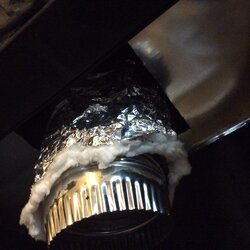Trying again...
The installer is coming tomorrow 1/12/17. He's putting in a Regency I3100 insert into my existing ~30 year old heatform by Heatilator (at least that's what I was told it was). They are removing several heat tubes to install the liner and maybe some of the existing damper.
We agreed on a two-phase install:
1. liner
2. Insert
In between the two steps will allow me to go in there and fabricate a block-off-plate. However the mentioned they can stuff the existing damper with insulation, they will not do the block-off-plate for me though - that's up to me.
My question and I need to know before they get here: will the insulation stuffed into the damper be sufficient?
The installer is coming tomorrow 1/12/17. He's putting in a Regency I3100 insert into my existing ~30 year old heatform by Heatilator (at least that's what I was told it was). They are removing several heat tubes to install the liner and maybe some of the existing damper.
We agreed on a two-phase install:
1. liner
2. Insert
In between the two steps will allow me to go in there and fabricate a block-off-plate. However the mentioned they can stuff the existing damper with insulation, they will not do the block-off-plate for me though - that's up to me.
My question and I need to know before they get here: will the insulation stuffed into the damper be sufficient?



 Definitely do the block off plate, I went a year without one because the dealer dismissed it. Had the come back on my dime this past fall to have them install one and the difference in heat & efficiency of the burn is substantial. You will also be much happier knowing the job was done right from the get go rather than having to second guess yourself and wonder if you could be getting much better heat & efficiency if you the block off plate. Good luck with that beast...I'm sure you'll love it
Definitely do the block off plate, I went a year without one because the dealer dismissed it. Had the come back on my dime this past fall to have them install one and the difference in heat & efficiency of the burn is substantial. You will also be much happier knowing the job was done right from the get go rather than having to second guess yourself and wonder if you could be getting much better heat & efficiency if you the block off plate. Good luck with that beast...I'm sure you'll love it